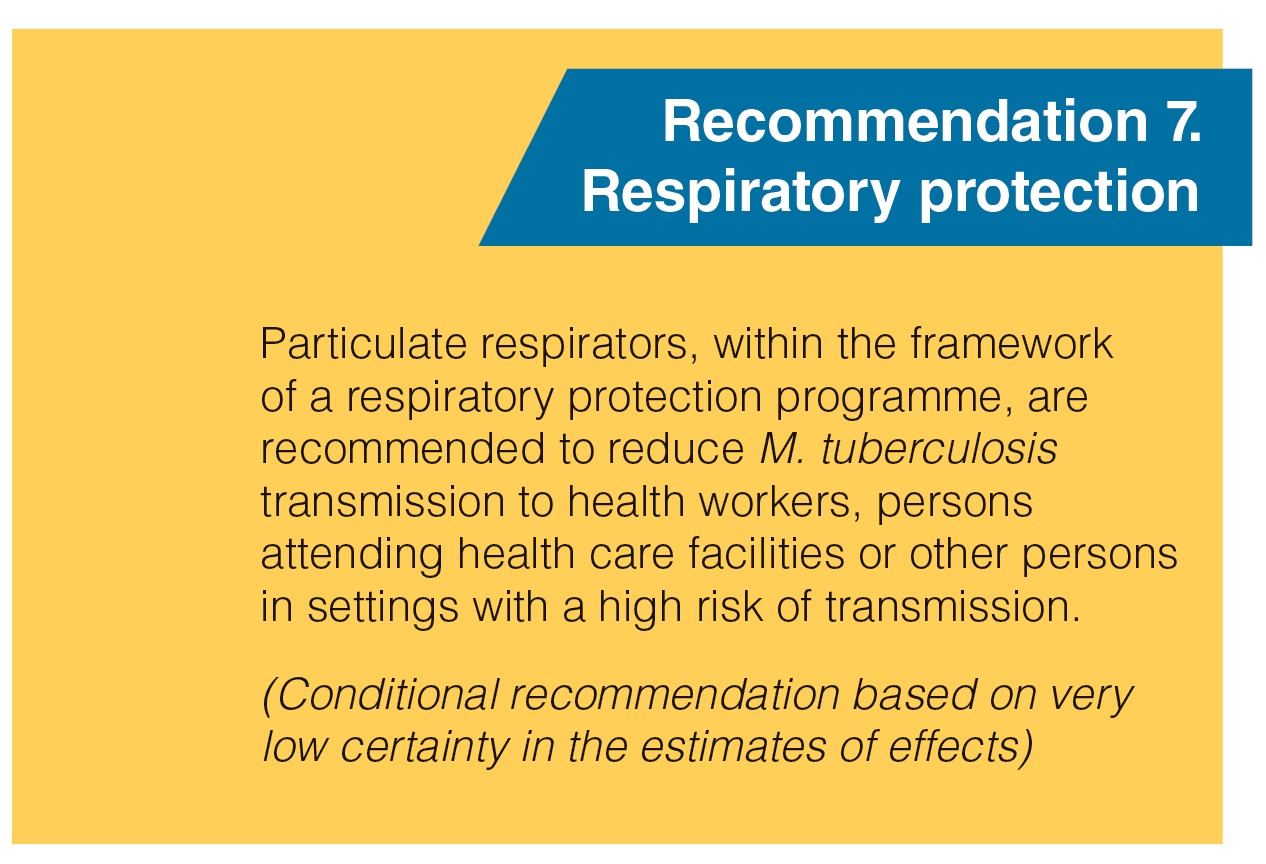Liens transversaux de livre pour 2.3 Respiratory protection
Respiratory protection controls are designed to further reduce the risk of exposure to M. tuberculosis (and other airborne pathogens) for health workers in special areas and circumstances. The recommendations given here are aimed at strengthening these controls, and preventing the inadequate implementation of respiratory protection programmes that may lead to a false sense of security and therefore increase the risk to health care staff.

Evidence and justification
A systematic review assessing the effectiveness of respiratory protection in reducing the risk of M. tuberculosis transmission yielded a total of nine studies (18, 20, 22, 24, 29, 30, 35, 42, 64) (see Online annexes 4 and 5). It was not possible to use meta-analysis, owing to the considerable heterogeneity between the interventions in the included studies. Most included studies found a reduction in the TST conversion rate with the use of particulate respirators by health workers, suggesting a reduction in the number of new TB infections. The magnitude of the effect varied considerably between the studies, but only one observational study indicated that respiratory protection did not reduce the incidence of LTBI – in this study, the reduction in the number of infections among health workers primarily occurred before the introduction of particulate respirators (22).
The systematic search also identified four studies in which respirators were used as part of a broader respiratory protection programme. No included studies focused on the implementation of respiratory protection programmes in non-health care congregate settings. The included studies provided heterogeneous results on the effect of such programmes to protect health workers from acquiring TB infection or developing TB disease. The reduction in TST conversion ranged from a 4.3% absolute reduction (with the introduction of particulate respirators and fit-testing as part of a respiratory protection programme) to a 14.8% reduction.
As observed in other interventions, a major limitation in the included studies was the inability to estimate the effect of the individual component of the intervention, because the intervention was introduced as a part of composite IPC measures. For example, the panel noted that determining the impact of respirators alone was impractical, given that respirator use is recommended within the framework of a comprehensive respiratory protection programme.
The Guideline Development Group indicated that the differences in effect estimates could be attributed not only to the variation in the composite interventions in different studies, but also to variations in the characteristics of study populations. The panel also recognized that multiple factors can affect the overall effectiveness of respiratory protection. In essence, the overall pass rate (level of protection) depends on whether respirators have been properly fit-tested and maintained, as well as the adequacy of the training for health care staff and other components of the respiratory protection programme.
Among the nine studies included in this systematic review, only two confirmed the use of formal respirator fit-testing before use of the respirator (20, 24). This means that additional variance in the observed effect in each study could be the result of variable levels of protection caused by respirator face pieces not being tightly fitted, resulting in lower pass rates. The Guideline Development Group rated the quality of the evidence as “very low” owing to concerns about indirectness and serious risk of bias.
Implementation considerations
Health care authorities must ensure proper allocation of resources to strengthen the implementation of TB IPC measures. The Guideline Development Group re-emphasized that the implementation of IPC measures must be adopted as a package of interventions based on a three-level hierarchy of controls.
In line with international standards on occupational safety and health, it is imperative that national health care authorities make use of particulate respirators for health workers only when a respiratory protection programme can be put in place. Attempting to establish one without the other may lead to overreliance on respirators, and give a false sense of protection.
When setting up respiratory protection programmes, health care authorities must also consider the provision of respiratory protection to include community health workers at risk of exposure to individuals with TB.
The panel acknowledged that an important advantage of properly implemented respiratory protection programmes is the appropriate use of particulate respirators and increased compliance among health workers. Effective implementation involves employee education and training activities on the proper use and maintenance (including repair and disposal) of particulate respirators, and periodic audits of practice.
The implementation of respiratory protection for health workers is recommended in health care facilities and other institutions where patients undergo treatment and care. Respiratory IPC measures, including the use of respirators, are also required for family members who are providing close care for patients with TB receiving palliative and end-of-life care.
Resources
Given that the use of particulate respirators is to be implemented within respiratory protection programmes, the necessary resources should be made available to ensure their proper functioning and sustainability. Although the panel emphasized that investment needs would depend on existing infrastructure and service demand, the allocation of resources seemed reasonable when compared with the estimated costs of treating TB in settings with a high risk of M. tuberculosis transmission.
Subgroup considerations
Health workers with impaired lung function (e.g. as a result of asthma or chronic obstructive pulmonary disease) may be physically unable to wear a particulate respirator.
Respirators should be worn by all personnel entering high-risk areas, in particular by health workers living with HIV, given the increased risk of developing TB disease if exposed in the workplace.
Settings and target population
The recommendation to use particulate respirators by health workers applies to all health care settings, and to non-health care congregate settings such as correctional facilities. It also applies to other settings where health care services are provided to individuals with presumed and confirmed TB (e.g. refugee and asylum centres).
 Retour
Retour